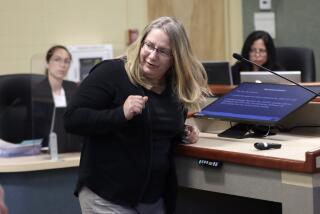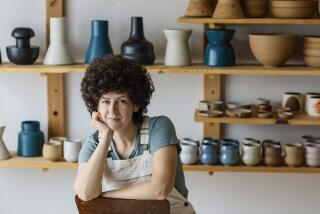Crafting a Business Takes Foresight
- Share via
Hilary Stern developed a love for handcrafted Italian ceramics while studying for a year in Italy during college. But after she graduated with a degree in marketing, she went to work as a public relations agent in New York, and then Sweden. It wasn’t until she received an inheritance from her grandfather that she decided to pursue her dream of importing the artisan pieces she admired so much. Now that she has survived her first year in retailing, Stern talked with freelance writer Karen E. Klein about the importance of choosing a location, planning start-up finances and calculating inventory costs.
*
When I arrived in Los Angeles after making contacts with artisans in Italy, I began looking for a location. I drove around looking for “for lease” signs in areas that I knew had heavy foot traffic. I quickly found that those locations were too large (around 1,000 square feet) and the prices were too high (from $4 to $8 a square foot).
Eventually, I found a great space and was ready to sign a lease. I knew foot traffic would be vital to my business, so I decided to park outside the space on a Saturday afternoon.
After seeing only two people walk by during a three-hour period, I decided to keep looking and was fortunate to find the small space I have now, near well-established gift stores and restaurants. There was good walk-by traffic, the size was right (500 square feet) and so was the price.
Next, I knew I needed to make sure I had enough initial capital. I estimated my start-up costs on paper, including fees for business licenses, DBA statement, sales permit and legal cost for setting up my business structure. I figured in leasehold improvements to my site, such as electrical work, painting, flooring, an awning and some structural changes. Then I estimated prices for display fixtures, cabinets and shelving, a counter, back storage shelving (I found you can find these much cheaper used by looking through classified ads), file cabinets that I got from a used office furniture store, and light fixtures.
I needed equipment, including a computer, credit card terminal and printer. I decided to write my sales manually and use QuickBooks at the end of the day to capture my sales. I felt a sophisticated point-of-sale system was too costly and not really necessary. I found used credit-card processing equipment for less than $200 advertised in the Recycler.
I decided to open my business checking account with a bank that also could process my credit card transactions as opposed to having to use an independent processing company. The advantage to using a bank that can process your transactions is that, although the discount rate may be slightly higher, the monthly service fees are generally lower, the transaction fees are lower (or waived in some cases), and most importantly, the money is deposited into your account the next day instead of having a two- to three-day lag time.
In my start-up budget, I also included all my supplies and miscellaneous fees, such as phone and utility deposits and building permits. Once I had a working budget, I added 20% because I knew I would go over it.
Next, it was time to calculate my break-even point, so I could determine how much inventory I needed. I set up an initial breakdown of my operating expenses, figuring in annual costs like insurance and interest on loans, and my monthly expenses such as rent, telephone and employee salary. I estimated that I would dedicate about 5% of my total sales to marketing and to cover credit card discount fees. I then established that I would have an average gross margin around 42%, which is a very conservative markup for my industry.
I was now ready to calculate my break-even point. To do the calculation, you add annual expenses ($14,600 in my case) plus 12-times monthly expenses ($2,900) and divide that by the gross margin (42%) minus my percentage expenses (5%). $49,400 divided by 0.37 gives you a break-even point of $133,514.
I knew now that I would need to earn $133,514 a year in sales to break even. Keep in mind that small specialty stores usually take two or three years to break even.
Then I was ready to project monthly sales. I used the National Retail Federation’s “Newspaper Advertising Planbook” to find out the national sales distribution percentages listed month by month for housewares, and used those as a guideline to forecast my first year’s sales, since I had no history on which to base my projections. To project my monthly sales I simply multiplied $133,514 by the monthly percentages. For example, the NRF projects 7.3% of total sales occur in January, 6.9% in February, and 10.2% in December. I multiplied $133,514 by .073 and set my January sales projection at $9,746. I took this formula and charted my sales for the year, modifying the figures as my actual sales came in.
I knew that in the housewares business, inventory turnover occurs about twice a year, so I wanted to have enough inventory on hand to cover my first six months. I averaged out my projected monthly sales to be $9,800 and multiplied that by 6.
I now knew that I would need to have $58,800 (in retail dollars) worth of inventory to open the store. Figuring an average 42% markup and taking into account my floor space, I budgeted for about $25,000 for inventory at cost.
I took the time and trouble to make these details projections because I knew that if I planned my start-up carefully, I could avoid overspending and I would optimize my cash flow in my crucial first year of operations.
(BEGIN TEXT OF INFOBOX / INFOGRAPHIC)
AT A GLANCE
* Company: D’Ilaria Italian Ceramics
* Owner: Hilary Stern
* Nature of business: Imports and sells Italian ceramics
* Location: 8313 W. 3rd St., Los Angeles 90046
* Year founded: 1999
* Employees: 1
* E-mail: hilary@dilaria.com
* Web site: https://www.dilaria.com
* Annual revenue: $75,000
*
If your business can provide a lesson to other entrepreneurs, contact Karen E. Klein at the Los Angeles Times, 1333 S. Mayflower Ave., Suite 100, Monrovia, CA 91016 or at kklein6349@aol.com. Include your name, address and telephone number.
More to Read
Inside the business of entertainment
The Wide Shot brings you news, analysis and insights on everything from streaming wars to production — and what it all means for the future.
You may occasionally receive promotional content from the Los Angeles Times.










